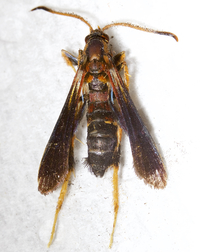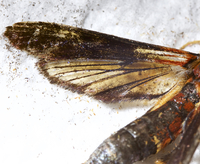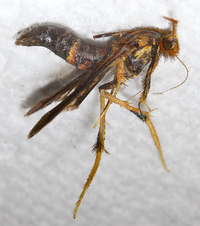Identification
Adult Markings: Podosesia aureocincta and P. syringae are sibling species and the adults are indistinguishable except for a distinctive orange-yellow band on abdominal segment 4 that is absent on P. syringae (Purrington and Nielson, 1977). In addition, local populations that are sympatric fly at different times of the year, with P. syringae typically flying in April-July in North Carolina and P. aureocincta in August and September. Both species are mimics of Polistes paper wasps. As of 2024, P. aureocincta is only known from a single site in Madison County, while P. syringae is widely distributed across the state. P. syringae , the antenna of P. aureocincta is orange to reddish-orange and blackish on the apical third. The thorax is brownish-black with red scales scattered above the base of the wings and immediately adjacent to the abdomen. The abdomen is brownish-black and is constricted at the base in males, but less so in females. There is a narrow, orangish-yellow band on the posterior margin of abdominal segment 4. The anal tuft is brownish-black and pointed, while the forewing is brownish-black, except for a small hyaline area at the base where there is red on the margins. The hindwing is hyaline with narrow, black margins. The terminal half of the legs are yellow, and the proximal half mixed with red, yellow, and black. The hindlimb is very long and is dangled beneath the body as the moth flies in a slow, hovering flight that resembles that of a paper wasp. The detailed description that is presented in the P. syringae account also applies to this species.
Forewing Length: 10-17 mm (Eichlin and Duckworth, 1988).
Genitalia and other structural photos
Adult ID Requirements: Identifiable from good quality photos of unworn specimens.
Immatures and Development: The larvae are borers that feed on ash trees, but details of the larval life cycle are poorly documented. The larval life-history and ecology is thought to be essentially identical to that of P. syringae (see detailed life cycle account of that species), with the females laying eggs on the bark and the larvae tunneling in the trunks and limbs of Fraxinus spp. from ground level to several meters above ground (Nielsen and Purrington, 1974). Because the adults emerge late in the year, the larvae have only a short time to grow before overwintering, which typically occurs in the second instar in Ohio, as opposed to fully grown larvae of P. syringae overwintering. The overwintering larvae continue burrowing throughout the summer months, then pupate a few weeks before the adults emerge in late-summer or early-fall.
Larvae ID Requirements: Identifiable from good quality photos, especially where associated with known host plants.

 »
»



 »
»

